
Kuala Lumpur blends tradition and modern life effortlessly. The day starts with lively markets and the aroma of freshly brewed kopi. As the day goes on, you can explore shopping malls, historic buildings, and hidden streets full of local finds. In the evening, the city comes alive with golden lights on the Petronas Towers and busy food stalls. KL’s mix of cultures is seen in its mosques, temples, and the friendly smiles of street vendors. Despite its fast pace, the city remains welcoming, making it an exciting yet comfortable place to visit.
Recommended eSIM Options for Traveling to Indonesia!
1 Hari - 2GB/Hari
- Data2GB/Hari
- Validitas1 Hari
- Hargadari Rp 14.868
7 Hari - 2GB/Hari
- Data2GB/Hari
- Validitas7 Hari
- Hargadari Rp 92.869
8 Hari - 1GB/Hari
- Data1GB/Hari
- Validitas8 Hari
- Hargadari Rp 71.892
Getting Around In Kuala Lumpur
🚗 Getting Around Kuala Lumpur – A Local Traveler’s Take on Transportation
When I first arrived in Kuala Lumpur, I was impressed by how easy it was to get around. Compared to Jakarta, the transport system here is more modern and efficient, but still has that lively hustle and bustle. The metro is fast and well-connected, making travel around the city effortless. Walking through Kuala Lumpur is a mix of energy and calm. Areas like Bukit Bintang are lively, while places like Lake Gardens offer peaceful spots to relax.
KL has plenty of transport options—metro, buses, and Grab taxis. There are also areas best explored on foot. I’ll share some tips soon, like which transport card to get, and how to navigate the city whether you're solo or with family.
🚇 Getting Around with Kuala Lumpur’s LRT System

(Source: soyacincau.com)
🗺️ System Overview

(Source: lahistoriaconmapas)
The LRT (Light Rail Transit) is one of the easiest ways to move around Kuala Lumpur. It mainly consists of two major lines:
Kelana Jaya Line (Pink): Fully automated and driverless.
Ampang & Sri Petaling Lines (Orange & Maroon): Conventional train system.
The LRT connects most shopping districts, tourist areas, and business centers, making it very convenient for travelers. Trains are modern, air-conditioned, and easy to navigate.
📍 Key Tourist Stops on LRT
Here are some stations you’ll likely use:
🔹KLCC Station 🌆 – Right under the iconic Petronas Twin Towers and Suria KLCC Mall.
🔹Bukit Bintang Station 🛍️ (via Monorail connection) – Heart of shopping, food, and nightlife.
🔹Pasar Seni Station 🏮 – Close to Central Market and Chinatown.
🔹KL Sentral Station 🚉 – Main hub connecting LRT, Monorail, KTM, and Airport Express.
🔹Masjid Jamek Station 🕌 – Great for exploring heritage sites and old Kuala Lumpur.
💳 Tickets, Cards, and How to Pay
| Ticket/Card | Description | Where to Buy |
|---|---|---|
Touch ‘n Go Card | Best for frequent rides. Works across LRT, MRT, KTM, and buses. | Ticket machines, customer service counters, KLIA Airport |
Single Journey Tokens | For one-time trips. Purchase at station machines. | Station machines |
KL TravelPass | Includes airport transfer + 2 days unlimited rides on LRT, MRT, and Monorail. | Ticket machines, customer service counters, KLIA Airport |
🕒 Operating Hours & Frequency
| Detail | Information |
|---|---|
First Train | Around 6:00 AM |
Last Train | Around 11:30 PM (varies slightly by station) |
Frequency | Every 3–8 minutes during peak hours, every 7–10 minutes off-peak |
✅ Pros & Ideal Users
🔹Solo travelers and couples: Super convenient and affordable 🚶♂️🚶♀️
🔹Families: Easy if you're not carrying heavy luggage.
🔹Commuters: Reliable for daily travel.
⚠️ Tips or Watch-Outs
🚨 Crowds: Avoid 7:30–9:00 AM and 5:30–7:30 PM if possible.
🗺️ Transfers: Some transfers (like from LRT to Monorail) require exiting one system and entering another (separate tickets unless using Touch ‘n Go).
🛑 Navigation: Watch for slightly confusing signage at busy stations like KL Sentral and Masjid Jamek.
🗣️ Language: Announcements are usually bilingual, but platform signs are clear in English.
Tip for Travelers:
✨If you're traveling with kids, try to avoid peak rush hour for a smoother ride.
✨For solo explorers, it’s the fastest and cheapest way to bounce between districts
🚇 Getting Around Kuala Lumpur with the MRT (Mass Rapid Transit)

(Source: seconddrop)
🗺️ System Overview
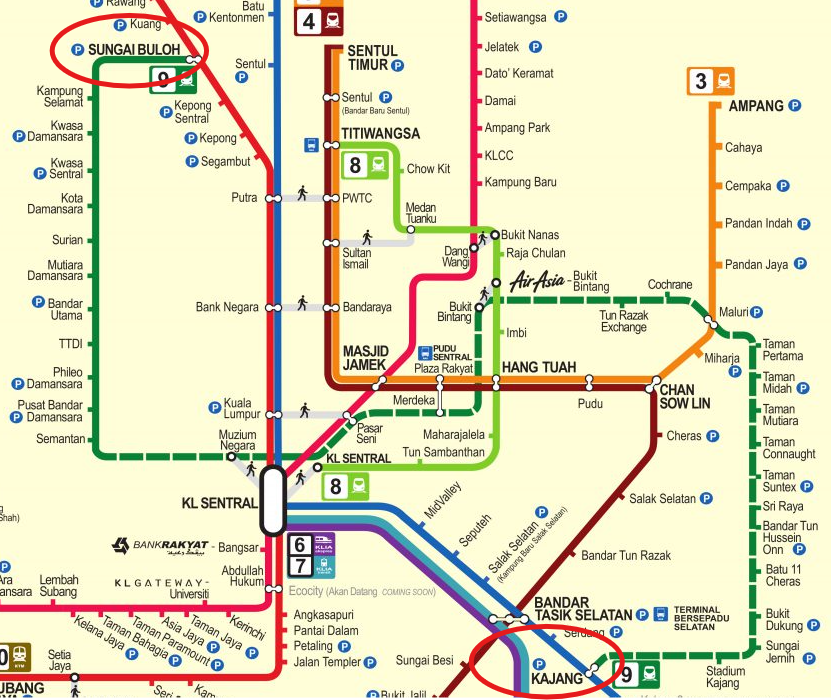
Kuala Lumpur’s MRT (Mass Rapid Transit) is one of the city's newest and most modern public transport options. It's designed to ease traffic and connect key areas quickly and affordably.
📍 Coverage: Covers major tourist spots, shopping hubs, and residential districts.
🚈 Lines: Kajang Line (Sungai Buloh–Kajang) — already operational. Putrajaya Line — recently launched, expanding city access.
🚆 Train Types: Modern, fully air-conditioned trains with clear station announcements.
📍 Key Tourist Stops (MRT Stations)
🔹Bukit Bintang (BBCC, Pavilion KL) 🛍️ – Shopping paradise!
🔹Merdeka Station 🏛️ – Access to Merdeka 118 and historical landmarks.
🔹Pasar Seni Station 🎨 – Art market, Chinatown, and Central Market.
🔹Muzium Negara Station 🏺 – Direct access to the National Museum.
🔹Titiwangsa Station 🌳 – Gateway to parks and quieter neighborhoods.
💳 Tickets, Cards, and How to Pay
Method | Details |
|---|---|
Touch ‘n Go Card | Reloadable card, accepted across MRT, LRT, buses, and more. |
Single Journey Token | Buy from station machines for one-time trips. |
KL TravelPass 🎟️ | Includes airport transfer + 2 days unlimited rides on MRT, LRT, Monorail. Great for tourists! |
Where to Buy | Ticket machines, customer counters at stations, KLIA Airport kiosks. |
🕒 Operating Hours & Frequency
Detail | Info |
|---|---|
First Train | Around 6:00 AM |
Last Train | Around 11:30 PM (varies slightly by station) |
Train Frequency | Every 3–8 minutes during peak hours 🚆; 7–10 minutes off-peak |
✅ Pros & Ideal Users
🔹Solo travelers and couples: Fast, clean, and affordable 🚶♂️🚶♀️
🔹Families: MRT stations have elevators and escalators for easier movement 👨👩👧👦
🔹Commuters: Reliable for daily use, with fewer delays.
🔹Comfort & Cleanliness: Modern trains, fully air-conditioned, clean interiors, with Wi-Fi at some stations 📶
Comparison to Jakarta's Commuter Line (KRL):
🔹KL's MRT is newer and offers a more spacious experience compared to Jakarta's KRL.
🔹The MRT has slightly fewer lines, but the comfort level is higher, and the interiors are cleaner.
⚠️ Tips or Watch-Outs
🔹Crowds: Best to avoid peak hours (7:30–9:00 AM and 5:30–7:30 PM) 💼🕒
🔹Transfers: Some interchanges (e.g., MRT to LRT) require walking through linked stations like Pasar Seni.
🔹Navigation: Most signage is easy to follow, but big hubs like Bukit Bintang can feel crowded.
🔹Language: English signs are everywhere, and announcements are bilingual 🗣️
Grab Flight Discounts To Kuala Lumpur
- One way
- Round-trip
- direct cheapest
 CGK19:252h 5mNonstopKUL22:30Jakarta - Kuala Lumpur|Tue, Feb 24|KLMMYR 123MYR 16928% OFF28% OFFMYR 169MYR 123
CGK19:252h 5mNonstopKUL22:30Jakarta - Kuala Lumpur|Tue, Feb 24|KLMMYR 123MYR 16928% OFF28% OFFMYR 169MYR 123  CGK17:002h 5mNonstopKUL20:05Jakarta - Kuala Lumpur|Tue, Feb 24|TransNusa AirlinesMYR 145MYR 16915% OFF15% OFFMYR 169MYR 145
CGK17:002h 5mNonstopKUL20:05Jakarta - Kuala Lumpur|Tue, Feb 24|TransNusa AirlinesMYR 145MYR 16915% OFF15% OFFMYR 169MYR 145 CGK21:152h 10mNonstopKUL00:25Jakarta - Kuala Lumpur|Tue, Feb 24|AirAsiaMYR 146MYR 16914% OFF14% OFFMYR 169MYR 146
CGK21:152h 10mNonstopKUL00:25Jakarta - Kuala Lumpur|Tue, Feb 24|AirAsiaMYR 146MYR 16914% OFF14% OFFMYR 169MYR 146 JKT1:00 PM3h 5mNonstopKUL2:00 PMJakarta - Kuala Lumpur|Sat, Dec 20|KLMFind More FlightsFind More Flights
JKT1:00 PM3h 5mNonstopKUL2:00 PMJakarta - Kuala Lumpur|Sat, Dec 20|KLMFind More FlightsFind More Flights
Displayed flight fares from ${{departCityName}} to ${{arrivalCityName}} are based on average prices across airlines for the next 3 months, according to the latest Trip.com database.
🚇 Getting Around Kuala Lumpur with the KTM (KTM Komuter)
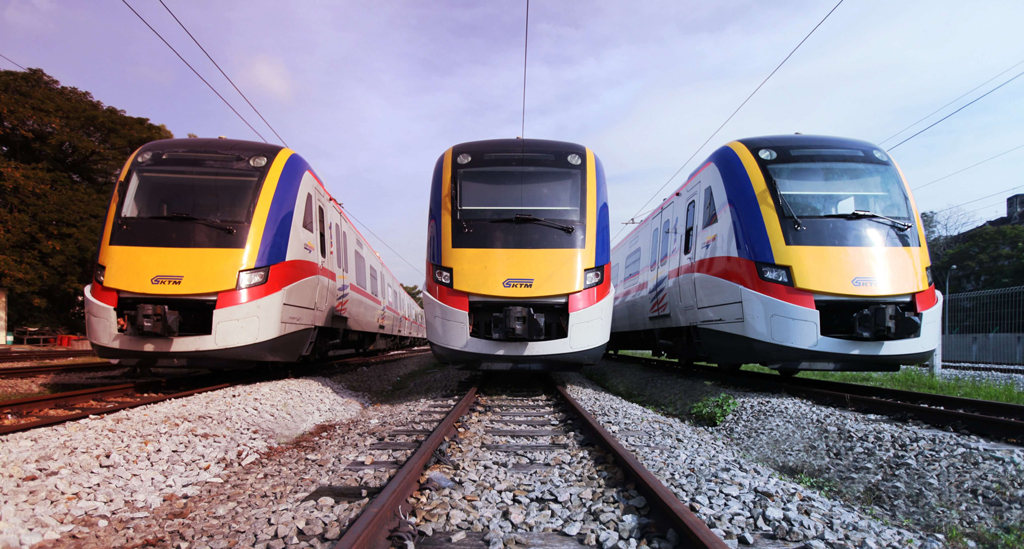
(Source: ktmb.com.my)
🗺️ System Overview

(Source: klia2info.)
The KTM Komuter (KTM) is one of Kuala Lumpur’s main train systems, offering a reliable and affordable way to travel within the city and its suburbs. Unlike the MRT, which focuses on the heart of the city, the KTM is perfect for exploring areas further out and connecting with regional destinations. 🚆
The system consists of two main lines:
🔹The Sentul–Port Klang Line (red line) connects the city center with the western suburbs, including important stops like KL Sentral.
🔹The Seremban Line (blue line) heads to the southern suburbs, making it great for tourists looking to explore beyond the city.
These lines are local trains, so they’re slower than the MRT but still very efficient and well-maintained, with air-conditioning for your comfort. ❄️
📍 Key Tourist Stops
Here are a few stations that tourists frequently use:
🔹KL Sentral 🏙️ – The central hub of Kuala Lumpur, where many tourists arrive and transfer to other lines, making it the perfect starting point for your journey.
🔹Mid Valley 🛍️ – A major shopping mall and office complex, ideal for a shopping spree or grabbing a bite to eat.
🔹Pasar Seni 🎨 – The cultural heart of KL, this station is close to the Central Market and Chinatown, offering a taste of local art and culture.
🔹KLCC 🏢 – While not directly served by the KTM, it’s easy to connect here via other trains for access to the famous Petronas Towers and Suria KLCC mall.
🔹Bandar Tasik Selatan 🏞️ – Great for connecting to the airport via the KLIA Transit for your next leg of the journey.
💳 Tickets, Cards, and How to Pay:
| Payment Method | Description |
|---|---|
Touch ‘n Go Card | A reloadable smart card used across most public transport in Malaysia. Easily purchased at stations or convenience stores. |
Single Journey Ticket | Buy a one-way ticket from ticket machines available at most stations. Ideal for short trips. |
One-Day Pass | Great for tourists. Unlimited rides for the day, offering flexibility to explore the city. |
🕒 Operating Hours & Frequency:
| Train Information | Details |
|---|---|
First Train | Around 5:30 AM |
Last Train | Around midnight |
Frequency (Peak Hours) | Every 10–15 minutes |
Frequency (Off-Peak) | Slightly longer than peak hours |
✅ Pros & Ideal Users
The KTM Komuter is perfect for solo travelers or families who want an affordable, straightforward way to get around the city. It’s generally clean, air-conditioned, and fairly comfortable. Business travelers can enjoy a quick and smooth ride to key business districts like KL Sentral, while tourists will find it an excellent option for hopping between
⚠️ Tips or Watch-Outs:
🔹Overcrowding During Peak Hours: Avoid rush hours (7:30 AM – 9:00 AM and 5:00 PM – 7:00 PM) if traveling with kids or if you prefer a quieter ride. 🚇
🔹Limited English Signage: English signage is available in most stations, but some areas may have limited English. Check route maps or ask staff for help.
🔹Transfers Between Lines: Transfers at larger stations like KL Sentral can be confusing. Keep an eye on signs or ask station staff for assistance.
🚇 Getting Around Kuala Lumpur with the Monorail
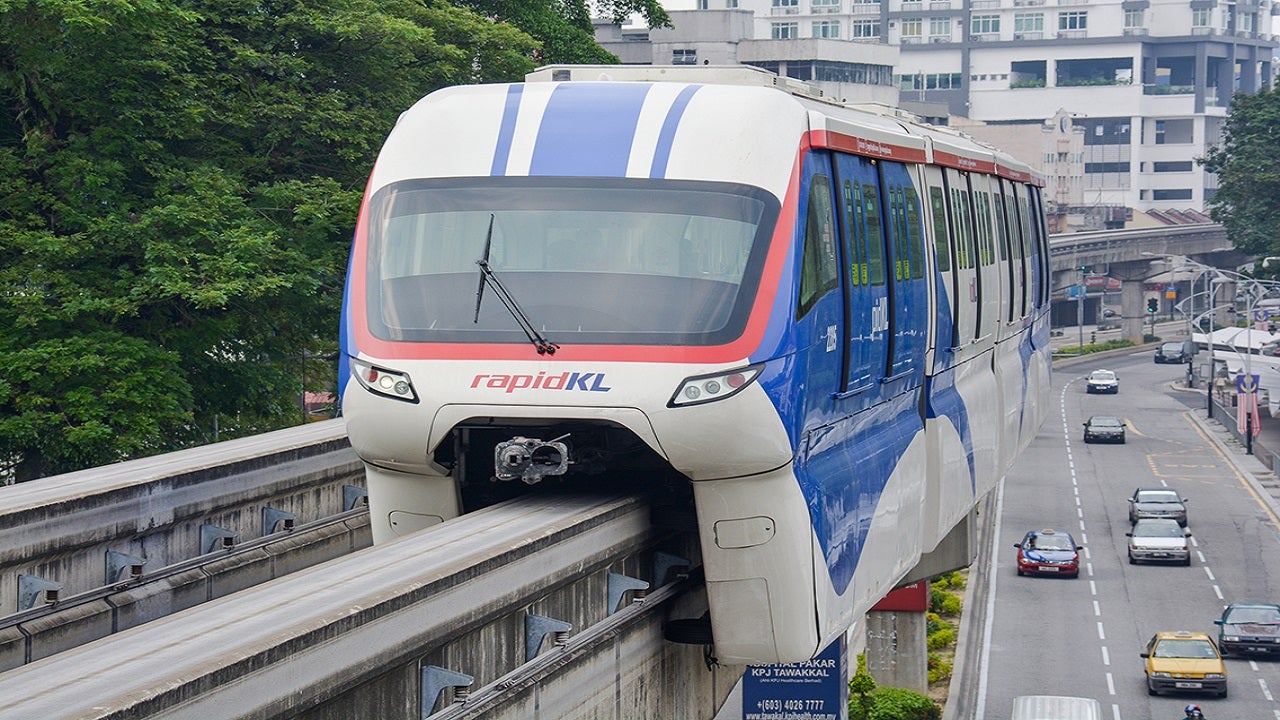
(Source: railway-technology.com)
🗺️ System Overview
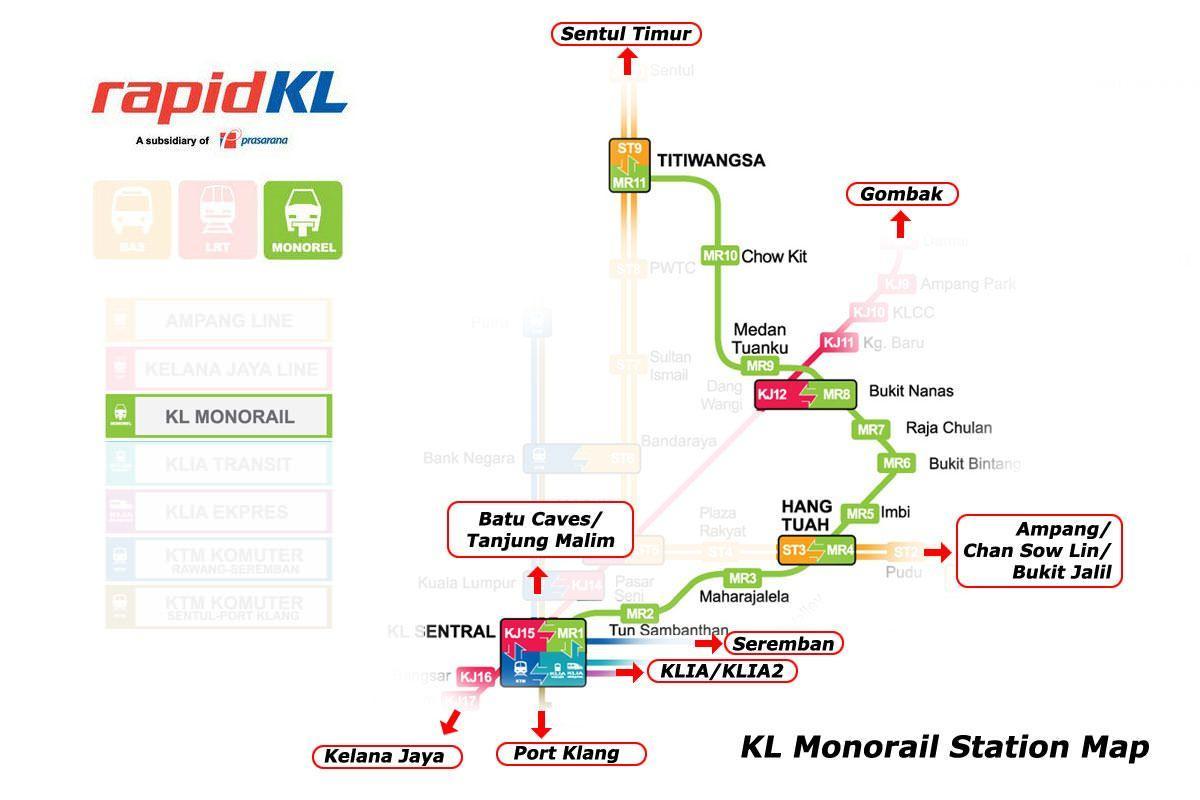
(Source: maps-kualalumpur.com)
The KL Monorail connects the city’s bustling districts, including the vibrant shopping areas, key landmarks, and entertainment hubs. This 11-kilometer elevated system is easy to navigate, with seven stations that cover both the city center and major tourist spots.
🔹KL Monorail: 11-kilometer elevated train system.
🔹Coverage: Connects shopping areas, landmarks, and entertainment hubs in the city.
🔹Stations: 7 stations in the city center and popular tourist spots.
🔹Ideal for: Short trips between malls, markets, and cultural sites.
🔹Train Lines: green color trains, with fast routes to key locations like Bukit Bintang.
📍 Key Tourist Stops
🔹Bukit Bintang: The heart of KL’s shopping district 🛍️, home to malls like Pavilion and Lot 10.
🔹KL Sentral: The transport hub of the city 🚉, perfect for transferring to other train lines or buses.
🔹Chinatown (Pasar Seni): A quick ride to experience local markets and heritage. 🏮
🔹Titiwangsa: A quieter stop, but great for parks and the National Art Gallery 🖼️.
💳 Tickets, Cards, and How to Pay
| Payment Method | Details |
|---|---|
Touch ‘n Go Card | Reloadable card for easy payments across most public transport in KL. Available at Monorail stations and convenience stores. |
Single-Journey Ticket | Purchase at machines for one-time trips, no need for a card. |
Tourist Pass | Unlimited rides for a day, perfect for sightseeing and hopping between attractions. |
🕒 Operating Hours & Frequency
| Operating Hours | 6:00 AM - 11:30 PM daily. |
|---|---|
Train Frequency | Trains every 4-6 minutes during peak hours. |
⚠️ Tips or Watch-Outs
🔹Peak Hours: The Monorail can get crowded during rush hours (7–9 AM, 5–7 PM), especially near Bukit Bintang and KL Sentral, so be prepared for packed trains.
🔹Language: While signage is in both Malay and English, it’s a good idea to double-check routes, especially if you’re unfamiliar with the city.
🔹Transfers: Some stations require transfers to other lines (e.g., to KL Sentral for the KTM or LRT), so follow the signs carefully to avoid confusion.
Hotel Recommendations In Kuala Lumpur
🚌 Rapid KL Shuttle Bus in Kuala Lumpur

(Source: says.com)
🚌 Local Bus System Overview
The RapidKL bus system is operated by Prasarana Malaysia and is the primary paid public bus service in Kuala Lumpur. It connects both central KL and its surrounding suburbs, making it a practical choice for locals and travelers who need to get around the city. With over 100 routes covering a wide range of destinations, RapidKL buses are a reliable way to travel, whether you're heading to commercial districts, residential areas, or some of the city's hidden gems.
While locals use RapidKL buses regularly for daily commutes, tourists can also benefit from its extensive network, especially if you need to reach areas that the metro doesn’t cover.
📍 When & Where to Use the Bus
🔹For Suburbs: If you’re staying outside the city center (e.g., Puchong, Cheras), RapidKL buses are great to get you to the city.
🔹Tourist Areas: It also connects to KL Sentral, Mid Valley, and Bangsar—areas with attractions and shopping.
💳 How to Pay & Ride
| Action | Details |
|---|---|
Payment | Use Touch 'n Go card (available at convenience stores). Fares: RM 1.00 to RM 5.00 (Rp 3,400 to Rp 17,000). Cash is also accepted, but have exact fare. |
Boarding | Tap your Touch 'n Go card at the front door. |
Exiting | Tap your Touch 'n Go card at the rear door. |
🕒 Timings & Frequency
| Action | Details |
|---|---|
Operating Hours | Buses run from 6:00 AM to 11:00 PM |
Frequency | During peak hours, buses arrive every 10-15 minutes. During off-peak times, buses may have longer waits. |
✈️ Airport Shuttle / Bus
For an airport connection, the SkyBus service is a better choice. It’s affordable, with a fare of RM 12 (Rp 40,000), and connects KLIA and KLIA2 to the city.
✅ Pros & Who It’s Good For
🔹Budget Travelers: Great if you’re looking for affordable transport.
🔹Locals & Commuters: Ideal for traveling between the city and suburbs.
🔹Explorers: Good for visiting quieter parts of the city.
Comparison to Indonesia: RapidKL buses are clean, air-conditioned, and offer a modern payment system—better than many Indonesian buses.
⚠️ Watch-Outs
🔹Language Barriers: Signs are mostly in Malay, so you might need help if you’re unsure of the route.
🔹Route Changes: There might be delays or changes, so always double-check or ask the driver.
GoKL Bus In Kuala Lumpur

(Source: klia2info)
🚌 Local Bus System Overview
The GoKL Bus system is a free bus service that primarily caters to tourists and travelers looking to explore the heart of Kuala Lumpur. Operated by RapidKL, GoKL focuses on covering key areas around the city center, including popular tourist destinations like Bukit Bintang, KLCC, Chinatown, and KL Tower. It’s very popular among tourists since it’s both cost-effective and convenient, allowing you to travel around without worrying about fares.
📍 When & Where to Use the Bus
🔹Scenic Routes: GoKL buses are perfect for sightseeing as they run through some of the most iconic parts of the city. For example, the GoKL Green Line connects you to central shopping areas like Bukit Bintang and KLCC, making it a great option for getting around the city while enjoying the sights.
🔹Popular Tourist Spots: If you’re planning to visit landmarks such as Petronas Towers, Chinatown, or KL Tower, GoKL buses are a stress-free way to hop between them.
💳 How to Pay & Ride
| Action | Details |
|---|---|
Payment | Free of charge for all passengers. No need for exact fares or cards. |
Boarding | Simply board the bus from the front door. No need to tap in or out. |
Disembarking | Exit through the rear door when you're ready to get off. |
🕒 Timings & Frequency
| Action | Details |
|---|---|
Operating Hours | Buses run from 6:00 AM to 11:00 PM |
Frequency | During peak hours, buses arrive every 10-15 minutes. During off-peak times, buses may have longer waits. |
✈️ Airport Shuttle / Bus
While GoKL buses are not directly connected to the airports, there are other airport shuttle options like the KLIA Express or SkyBus that offer a comfortable ride to and from the city center. These services are separate from the GoKL bus system but are still a budget-friendly way to get to your destination.
For late arrivals, if you’re traveling with heavy luggage, the airport shuttle might be a more practical choice than the GoKL bus.
✅ Pros & Who It’s Good For
🔹Great for budget travelers: Since GoKL buses are free, it’s an ideal option for tourists who want to explore the city without spending extra on transport.
🔹Perfect for slow explorers: If you enjoy taking your time and seeing the sights at a relaxed pace, GoKL offers a convenient and comfortable way to navigate the central areas of Kuala Lumpur.
🔹A good intro to the city: The routes pass through several must-see areas, so it’s a good introduction to the city vibe for first-time visitors.
Comparison to Indonesian buses: Compared to buses in cities like Jakarta, GoKL is notably more tourist-friendly with its clear routes, air-conditioned buses, and ease of use—especially since it’s completely free of charge.
⚠️ Watch-Outs
🔹Signage: While the GoKL buses are easy to navigate, some of the signage may be in Malay, which could be tricky for those who don’t speak the language. But don’t worry—just look out for signs indicating the route number and the main stops.
🔹Route Changes: The routes for GoKL buses may change occasionally due to events or road closures, so it’s always a good idea to check the latest updates on the GoKL website or local bus schedules.
🔹Apps: Some apps used to track bus schedules might not be as reliable as you’d expect, so it’s better to keep an eye on bus timings directly at bus stops or ask locals for assistance if needed.
🚕 Taxis & Ride-Hailing in Kuala Lumpur
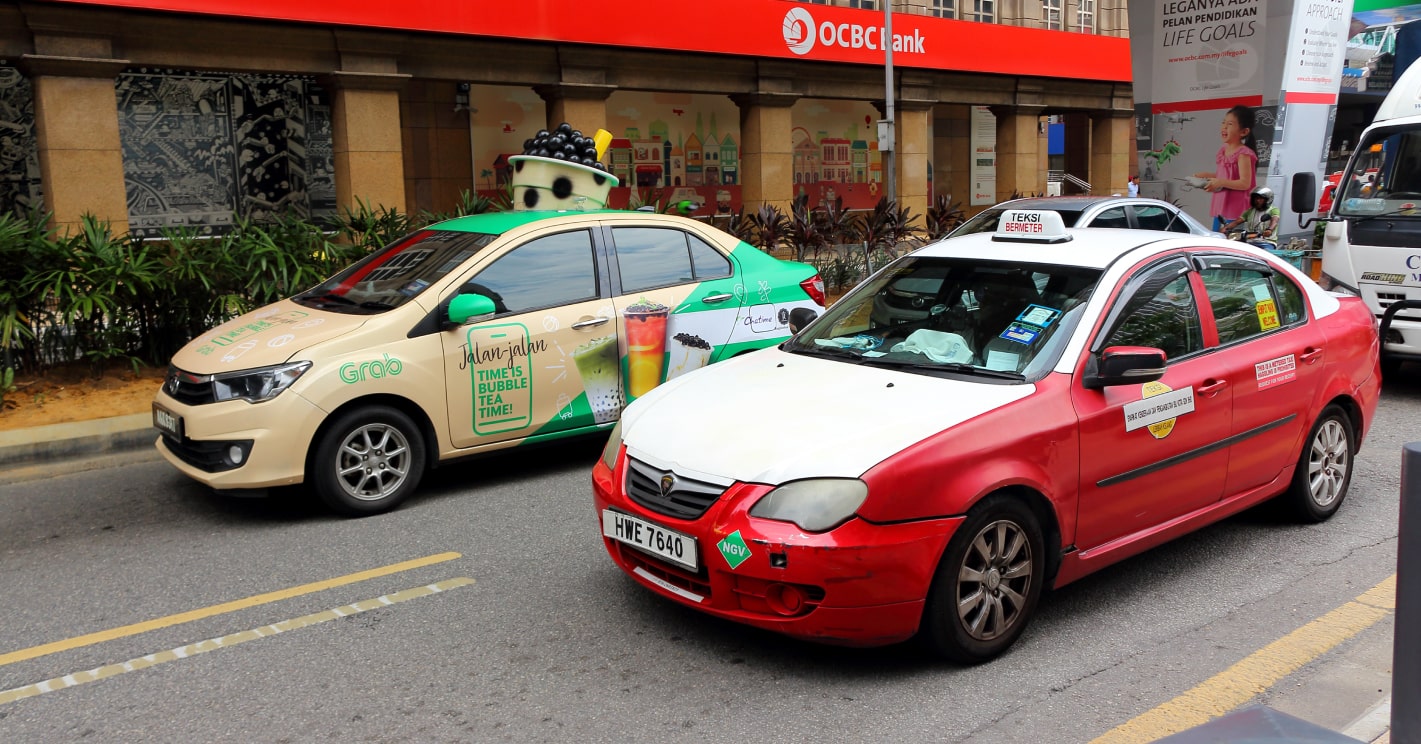
(Source: pendapat.my)
🚖 Availability & Reputation
In Kuala Lumpur, taxis are widely available, but ride-hailing apps are more popular and often preferred by travelers. Taxis can be flagged down on the street or found at designated taxi stands. However, they are prone to scams—especially if the driver doesn’t use the meter. It's common for unmetered taxis to overcharge tourists, so always insist on using the meter or agree on a fare upfront.
On the other hand, ride-hailing apps like Grab are a safe, convenient, and reliable option. They're widely used in KL and tend to be more transparent and affordable, with no need for haggling.
📱 Popular Ride-Hailing Apps
The most popular ride-hailing app in Kuala Lumpur is Grab. It’s the go-to platform for both locals and tourists, offering upfront pricing and in-app payments (credit/debit cards or e-wallets). Here’s why Grab is great:
🔹Available for download: Grab is available on both the App Store and Google Play.
🔹Upfront Pricing: See your fare before you book.
🔹In-app Payments: Pay directly through the app using a credit card or e-wallet.
🔹Language Options: The app is available in English and Malay.
Grab is generally the best app to use in KL, especially for first-time visitors, as it offers clear communication, guaranteed pricing, and great customer support.
💸 Fare Estimates & How to Pay
| Fare Type | Details |
|---|---|
City Center to Airport | RM 65–RM 80 (IDR 220,000–IDR 270,000) by Grab |
Metered Taxis | Fares are metered but can be unpredictable due to scams. Insist on the meter. |
Ride-Hailing (Grab) | Fixed fare, no surprises. Grab may offer discounts or promotions |
Night Surcharges | RM 2–5 applies for rides between 12:00 AM and 6:00 AM |
Tolls | Toll charges may apply if traveling via highways (usually included in Grab's fare). |
🛬 Airport Pickup Info
🔹KLIA Taxi Rank: The official KLIA taxi rank is located on the ground floor of the KLIA main terminal. It’s best to use the taxi coupon system here to avoid overcharging.
🔹Grab Airport Pickup: You can also pre-book a Grab ride from KLIA. Look for the Grab pickup zone outside the arrivals area. Surcharges apply, and it's usually more affordable than a regular taxi.
✅ Best for These Travelers
| Traveler Type | Why Ride-Hailing is Ideal |
|---|---|
Families with Kids | Comfortable and safe for children. The Grab app makes it easy to book a ride. |
Seniors | Grab provides a private ride, ideal for seniors who prefer convenience over public transport. |
Late-Night Arrivals | Ride-hailing apps like Grab are reliable even late at night, when taxis may be limited. |
Luggage Travelers | With private taxis or Grab, you have more space and convenience compared to buses or trains. |
⚠️ Things to Watch Out For
🔹Taxi Scams: Be cautious if the taxi driver says the meter is broken or tries to offer a flat fare. Always insist on using the meter or agree on a price before you start the ride.
🔹Ride-Hailing Availability: During peak hours, bad weather, or in remote areas, there may be limited availability of ride-hailing cars. You may need to wait a little longer.
🔹Unofficial Drivers: Avoid unofficial taxis or touts at the airport or tourist areas. Always use the official taxi rank or a recognized ride-hailing app.
🚶 Walking & Exploring on Foot in Kuala Lumpur

(Source: foongpc.com)
🚶 Is Kuala Lumpur Walkable?
Kuala Lumpur is a mixed bag when it comes to walkability. While the city has been improving its pedestrian-friendly infrastructure, it’s still a work in progress compared to the highly walkable streets of Singapore. However, the key tourist areas are clustered and can be easily explored on foot.
🔹Bukit Bintang: A popular shopping district that’s full of life. It’s great for walking between malls, cafes, and street food spots.
🔹Chinatown (Petaling Street): A vibrant area with narrow lanes perfect for a stroll while enjoying the hustle and bustle of markets and eateries.
🔹KLCC Park: A beautiful green space near the iconic Petronas Towers, offering a scenic walk with great views of the skyline.
🛣️ Sidewalks, Crossings & Navigation
Kuala Lumpur’s sidewalks can vary in quality depending on the area.
🔹In the city center, sidewalks are generally well-maintained, especially around popular tourist areas like Bukit Bintang and KLCC.
🔹However, narrow sidewalks or broken pavements are common in some parts of the city, particularly in less touristy neighborhoods.
🔹Pedestrian crossings are widely available, but drivers don’t always respect them, so be cautious when crossing busy streets.
🔹Accessibility can be a challenge in certain areas with steep hills or uneven paths, especially if you’re venturing outside the main tourist districts.
🗺️ Maps, Signage & Safety
| Navigation & Safety | Details |
|---|---|
Navigation | Google Maps works well for getting around on foot in Kuala Lumpur. It's usually reliable for walking routes. |
Signage | Signs are in both Malay and English, making it easy for English-speaking travelers to navigate. |
Safety | KL is generally safe to walk in during the day. At night, avoid deserted areas and poorly lit streets. Stick to popular areas like Bukit Bintang and KLCC where it's safe for solo travelers. |
🌦️ Weather Considerations
The weather in Kuala Lumpur can be hot and humid year-round, with regular rain showers, particularly in the afternoon. Make sure to dress comfortably, carry a water bottle, and wear comfortable shoes for walking. The tropical climate can make walking exhausting, so be prepared for sudden downpours. If it’s too hot, take a break in the air-conditioned malls or cafes.
🔹Rainy season: Be mindful of the rainy season (typically from March to October) when sudden downpours can leave streets flooded. Always have an umbrella handy!
🏞️ Scenic Walks or Hidden Gems
🔹KLCC Park: A perfect spot for a relaxing walk with scenic views of the Petronas Towers and a man-made lake. You can stroll around the park and enjoy the greenery in the heart of the city. 🌳
🔹Merdeka Square: Rich in history and culture, this area is perfect for taking photos while enjoying the colonial architecture.
🔹Jalan Alor: A food street in Bukit Bintang, where you can explore local flavors while enjoying the bustling street vibe. 🌮🍜
✅ Who It’s Great For
| Traveler Type | Why It's Great for Walking |
|---|---|
Solo Travelers | Safe and easy to navigate in popular areas, great for exploring at your own pace. |
Couples | Take a romantic walk in KLCC Park or along Merdeka Square, enjoying the skyline and vibrant streets. |
Photo Lovers | The city has plenty of photogenic spots, from modern skyscrapers to traditional markets and parks. |
Central Area Stay | If you're staying in the city center, walking is a great way to get around, with many attractions within walking distance. |
⚠️ What to Watch Out For
🔹Traffic-heavy roads: Some areas have narrow sidewalks, especially on Jalan Raja Laut and Jalan Pudu, so watch out for speeding cars and motorbikes.
🔹Unexpected closures: Construction and street closures can disrupt your route, especially near Kuala Lumpur Sentral or Chinatown. Always check for detours or be prepared to walk a little further.
🔹Lack of Shade: In some areas, walking might get uncomfortable due to a lack of shade, particularly during the mid-day heat. Take breaks when needed!
🚕 Unique Local Transport in Kuala Lumpur: Fun & Iconic Rides

(Source: travelog.com)
If you're a first-time visitor to Kuala Lumpur or just want to see all the city’s highlights without the hassle of navigating busy streets, the KL Hop-On Hop-Off Bus is an awesome way to explore! It’s one of the most relaxed and tourist-friendly modes of transport in the city. Let’s dive into why you should give it a go! 🏙️🚌
🚋 What It Is & Where to Find It:
The KL Hop-On Hop-Off Bus is a double-decker, open-air bus that takes you on a guided tour of Kuala Lumpur’s top attractions. The bus makes stops at over 20 key destinations, including landmarks like Petronas Twin Towers, Merdeka Square, KL Tower, and Batu Caves! 🚏🗺️
You can catch it at designated stops throughout the city, mainly near popular tourist areas like Bukit Bintang, KLCC, and Chinatown. Just look out for the bright red buses cruising by! 🎨
💰 Cost & How to Ride:
| Ticket Type | Price (MYR) | Price (IDR) | How It Works |
|---|---|---|---|
1-Day Pass | RM 45 | Rp 150,000 | Hop on and off at any of the listed stops. Buses run every 30 minutes, so no rush! ⏰ |
2-Day Pass | RM 75 | Rp 250,000 | Same as the 1-day pass, but with two days to explore. Enjoy more time to hop on and off at leisure! 🚌 |
🎯 When It’s Worth Trying
🔹KL Hop-On Hop-Off Bus is a great option for visitors who want to see the city's must-see sights without dealing with KL’s notorious traffic or the hassle of finding parking.
🔹The bus route is perfect for tourists looking to hit all the major attractions, especially if you have limited time and want to make the most of your trip! It's also fantastic for groups orfamilies who want an easy, comfortable way to get around. 👨👩👧👦
🔹Scenic Routes: While riding on the upper deck, you’ll have fantastic views of the city’s skyline, which is especially breathtaking at sunset or after dark when the lights come on! 🌇✨
⚠️ Things to Watch Out For
🔹Crowds: Since it’s a popular tourist activity, the buses can get crowded, especially during peak tourist seasons. Be prepared for some waits at the bus stops during busy times.
🔹Traffic Delays: KL traffic can be unpredictable, so sometimes the bus might get delayed. Plan your day accordingly, especially if you’re on a tight schedule! 🚦
🔹Bus Frequency: While buses come every 30 minutes, they can occasionally be delayed during rush hours, so check the schedule or give yourself some buffer time for sightseeing. 🕒
✅ Who It’s Great For:
🔹The KL Hop-On Hop-Off Bus is perfect for first-time visitors, those who want an easy introduction to the city, and travelers who prefer comfort and convenience over navigating public transport. 🎒
🔹Not ideal if you're someone who likes to explore at your own pace, as you'll be following the bus schedule and stops. It's also less suited for those with large luggage or for fast-paced travelers. 🏃♂️
🛵 Scooters & Micro-Mobility in Kuala Lumpur
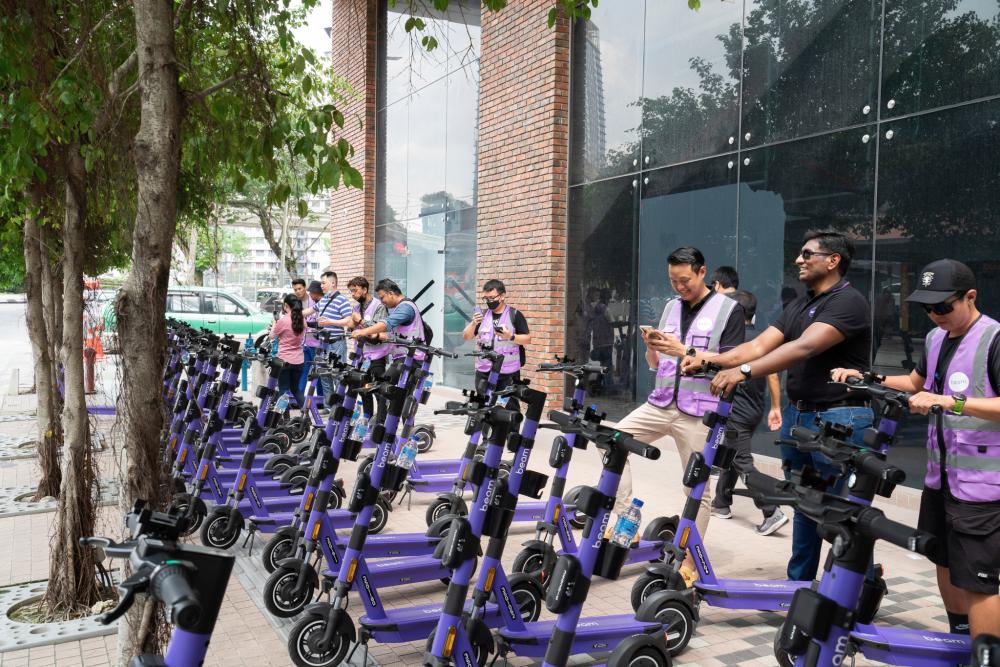
(Source: news.nestia.com)
Navigating Kuala Lumpur is a breeze with the help of e-scooters and bicycles. These micro-mobility options are not only practical but also a fun and eco-friendly way to explore the city. Whether you’re dodging traffic or just want a unique way to get around, these services are a great choice for short trips in Kuala Lumpur.
🛵 What’s Available:
In Kuala Lumpur, e-scooters are available through services like Beam. These are official, app-based services, offering quick rides around the city. For a more relaxed ride, shared bicycles are also available in some areas through services like Mobike and HelloBike.
Both e-scooters and bicycles are dockless, meaning you can pick them up and drop them off at various points throughout the city, as long as they’re within the designated service areas.
📍 Where to Find Them:
🔹Beam e-scooters are dockless, so you can find them in key areas like KLCC Park, Merdeka Square, and around Bukit Bintang. Just unlock them via the app, and you’re off!
🔹Bicycles are found in key areas, especially near parks and shopping districts. Simply find a nearby station or pick up a bike on the app to start riding.
📲 How to Use:
| Service | App | How to Use | Fare |
|---|---|---|---|
Beam e-Scooters | Beam | 1. Download the Beam app. | RM 1 - RM 2 per minute |
Bicycle Rentals | Mobike, HelloBike | 1. Download the Mobike or HelloBike app. | RM 1 for 30 minutes |
🛡️ Safety Tips:
🔹When riding e-scooters, be sure to wear closed-toe shoes, avoid flip-flops, and keep your balance by holding the handlebars firmly. Always be cautious around pedestrians and traffic.
🔹For bicycles, wearing a helmet is recommended, though not always provided. Make sure to wear comfortable clothes and avoid riding in high heels or sandals.
✅ Ideal For:
🔹Short distances between key attractions, avoiding traffic jams.
🔹Solo travelers and commuters who need a quick way to get around or explore.
🔹Great for hopping between shopping malls, parks, and landmarks like Merdeka Square, Bukit Bintang, and KLCC.
⚠️ What to Watch Out For:
🔹Surge pricing: During peak hours, you may face higher fares for e-scooters, especially during rain.
🔹Insurance: Keep in mind that most micro-mobility services do not include personal insurance, so ride with caution.
🔹Rain or poor roads: These services may not be ideal when it’s rainy or the roads are in bad condition. Also, carrying luggage on a scooter or bike is not recommended.
🚗 Car Rentals & Driving in Kuala Lumpur

(Source: carsifu.my)
Driving in Kuala Lumpur can be an exciting adventure, but it’s essential to know when it makes sense to rent a car and when it’s better to stick to other transportation options. If you're used to organized roads and clear signage like in Singapore, Kuala Lumpur might feel a bit overwhelming at first. However, with the right preparation, renting a car can offer flexibility, especially if you're heading out of the city.
🚘 When It Makes Sense to Drive:
Renting a car in Kuala Lumpur can be a good idea for:
🔹Day trips outside the city, such as exploring the countryside or cultural sites in places like Genting Highlands or Malacca.
🔹Traveling with kids or a group, where public transport might be less convenient.
🔹Exploring suburban areas or areas not well-connected by public transit. However, within the city, driving might be stressful due to heavy traffic, limited parking, and narrow streets in certain areas.
📍 Where to Rent a Car:
You can rent a car from outlets around Kuala Lumpur International Airport (KLIA) or KLIA2, or at various city locations. Booking in advance through platforms like Trip.com is a great way to compare car rental options for the best deal. Online booking often gives you more flexibility and allows you to pick up your car at a convenient spot.
📄 Requirements for Tourists:
| Requirement | Details |
|---|---|
International Driving Permit (IDP) | Not required if you have a valid Singaporean driving license. However, bringing your IDP is recommended for ease. |
Minimum Age | Most rental companies require you to be at least 23 years old to rent a car. |
Documents Needed | Passport, driver’s license, and a credit card for the security deposit. |
Local Insurance | Basic coverage is included. You can upgrade to collision damage waivers or comprehensive insurance for added peace of mind. |
💸 Cost Overview:
| Cost | Details |
|---|---|
Daily Rental Rates | RM 150 to RM 250 (Rp 540,000–Rp 900,000) for a standard car. Luxury or larger cars cost more. |
Deposit | RM 500 to RM 1,000 (Rp 1,800,000–Rp 3,600,000), refundable when the car is returned in good condition. |
Fuel Policy | Full-to-full: pick up with a full tank and return full. Fuel costs around RM 2.10 to RM 2.50 (Rp 7,500–Rp 9,000) per liter. |
Additional Costs | Tolls for expressways and parking fees in areas like KLCC and Bukit Bintang can be expensive. |
🛣️ Driving Conditions & Culture:
🔹Traffic: Kuala Lumpur’s traffic can be hectic—especially during peak hours, with congestion in central areas. The road network is well-developed, but expect slow-moving traffic, especially on main roads and highways.
🔹Local habits: Locals tend to drive aggressively, and it's common to see vehicles change lanes abruptly. Be alert and keep a safe distance.
🔹Road signs: Most road signs are in English, so it’s relatively easy for English speakers to navigate.
🔹Driving side: Left-hand side of the road (same as Singapore), so driving should feel familiar.
🔹GPS reliability: GPS apps like Google Maps or Waze work well in Kuala Lumpur, but always double-check your route to avoid congested roads.
⚠️ What to Watch Out For:
🔹Tight alleys and narrow roads: Some areas in the city center have narrow lanes or one-way streets, so be cautious.
🔹Parking challenges: Parking in Kuala Lumpur, especially in shopping districts, can be tricky. Look for public parking lots or designated parking zones. Be aware of restricted areas to avoid fines.
🔹Steep roads: In some hilly areas like Genting Highlands, driving can be challenging due to steep inclines.
✅ Ideal Travelers:
🔹Families who want to explore outside the city.
🔹Business travelers needing flexibility to move around the city and surrounding areas.
🔹Couples planning countryside day trips or visits to nearby attractions.
Final Thoughts
Getting around Kuala Lumpur is part of the fun of exploring this vibrant city! Whether you're zipping around in a KL Monorail car, hopping on a Grab ride, or cruising through the city streets on a Beam scooter, there's always something exciting about how the transport system weaves into the city's pulse. Sure, the traffic can be a bit wild during rush hour, but that’s just part of the Kuala Lumpur charm. Mix and match transport options to truly experience the city like a local, and don’t forget to use your mobile data to make the most of navigation apps. It's all about flexibility and convenience! If you’re planning the next leg of your adventure, be sure to check out options for airport transfers, car rentals, or some fun things to do in Kuala Lumpur. Safe travels!

 NO.1
NO.1


